Taylor 14CE Grand Auditorium - Cutaway, Electronics, Natural
- Vendor
- Taylor
- Regular price
- $499.00
- Sale price
- $499.00
- Regular price
-
$499.00 - Unit price
- /per
Adding product to your cart
- Description
- More
- Features
- Specs
- Inspection and Set-up
- Humidity Care
*These are stock photos. Actual color and pattern may vary.
Offering the accommodating feel and vibrant sound of a full-size, standard-scale cutaway Grand Auditorium, the Taylor 14ce delivers great value for players in earch of a versatile, reliable acoustic-electric. Layered African sapele back and sides paired with a solid torrefied spruce top produce a clear, articulate voice with impressive projection and a touch of sweetness, thanks to our special roasting process that adds warmth and maturity to the tone. Cantilevered V-Class voicing architecture inside the guitar enhances the sustain, volume and low-end response, while a slender, heelless maple neck delivers familiar Taylor playability. Minimalist appointments like a matte finish, 4mm dot inlays and faux-tortoiseshell pickguard add to the 14ce’s understated visual appeal. It ships in a gig bag with an onboard Fishman Sonitone GT-2 pickup for amplified play across a wide range of musical settings.
- CASE/GIG BAG: Gig Bag Included.
Rich Acoustic Tone in a Player-Friendly Package
A comfortable body, slender neck profile, tone-enhancing interior bracing and onboard electronics deliver a complete playing experience regardless of your skill level.
Grand Auditorium
Taylor’s signature shape embodies the ultimate all-purpose acoustic.
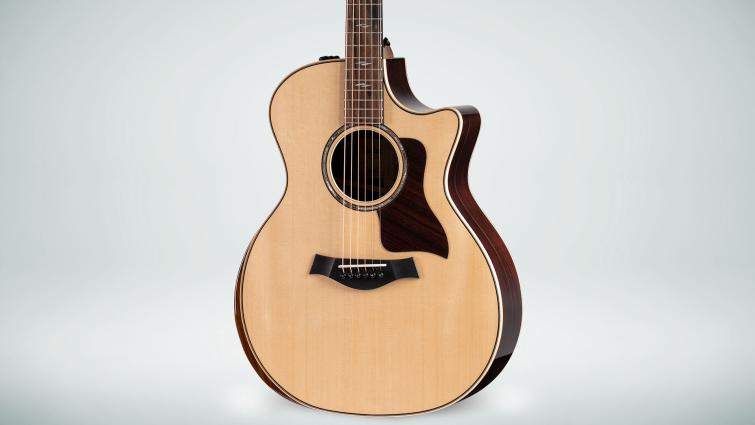
Sapele
One of the best all-around tonewoods there is, sapele will deliver for any playing style.
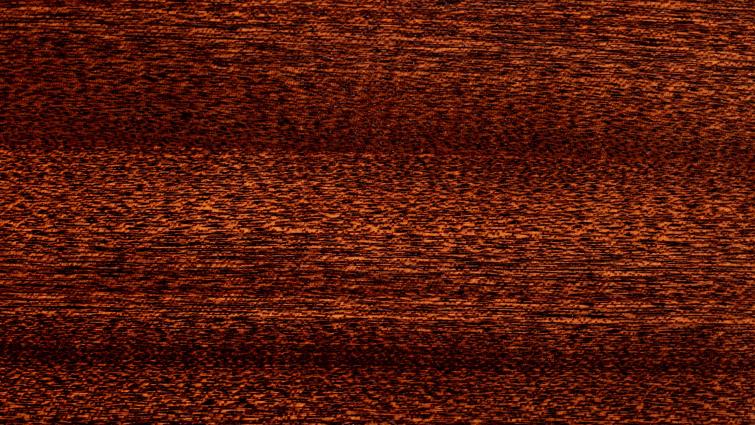
The Taylor Neck
Introduced in 1999, the patented Taylor Neck offers legendary playing comfort, exceptional intonation and easy adjustability.
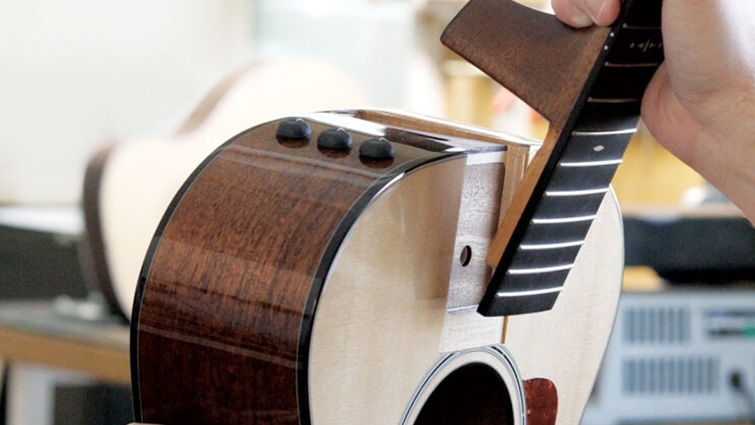
Torrefied Spruce
Treated with our special roasting process, torrefied spruce tops deliver all the clarity, balance and projection you’d expect from a traditional spruce top with an extra dash of warmth and played-in depth.

Fishman Sonitone GT2
Featuring soundhole-mounted volume and tone controls, the Fishman Sonitone GT2 delivers clear, authentic acoustic tone in Taylor models designed with beginners and everyday players in mind.
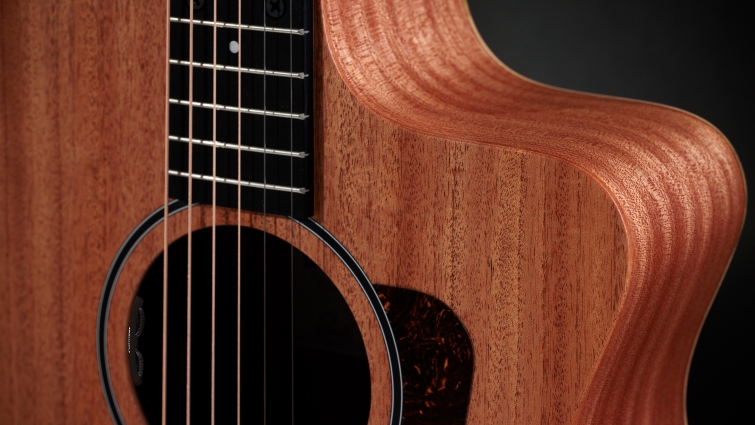
Venetian Cutaway
The Venetian cutaway is known for its soft, round lines. The sloping peak of the cutaway will vary depending on the shape of the body.
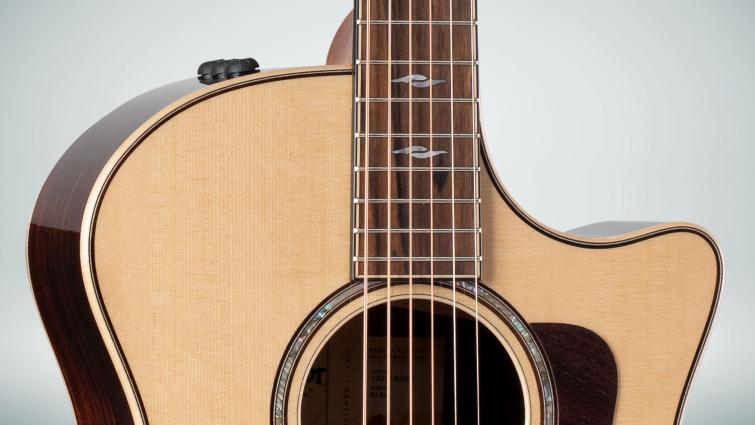
- Solid torrefied spruce top for projection and warmth
- Versatile, comfortable Grand Auditorium body shape
- Taylor neck for smooth playability
- Features Fishman Sonitone GT-2 pickup for plugged-in play
- Includes structured gig bag for storage and transport
Highlights
- Number of Strings: 6 String
- Orientation: Right Handed
- Body Shape: Grand Auditorium
- Bracing System: C-Class Bracing
- Cutaway: Venetian Cutaway
- Color: Natural
- Electronics: Fishman Sonitone GT2
Body
- Top Wood: Torrefied Spruce
- Back/Side Wood: Sapele
- Rosette: Black Plastic Single Ring
- Back Configuration: Layered, 2-Piece
- Body Binding: None
- Armrest: None
- Top Finish: Matte
- Back/Side Finish: Matte
Neck
- Neck Wood: Hard Rock Maple
- Fretboard Wood: West African Crelicam Ebony
- Neck Profile: Standard Carve
- Fretboard Inlay: Faux Pearl 4mm Dots
- Fretboard Binding: None
- Neck Finish: Matte
Peghead
- Nut Width: 1-11/16"
- Peghead Veneer Wood: Copafera
- Scale Length: 25-1/2"
- Peghead Inlay: None
- Peghead Type: Paddle
- Peghead Binding: None
- Peghead Finish: Matte
Other
- Bridge: West African Crelicam Ebony
- Nut & Saddle: White NuBone Nut, White Micarta Saddle
- Bridge Pins: Black ABS Plastic
- Strings: D'Addario XS Coated Phosphor Bronze Light (.012 - .053)
- Pickguard: Black
- Tuners: Die-cast Chrome with Chrome Buttons
- Strap Pin: Chrome
- End Pin: Chrome
At Easy Music Center, we care for our instruments from the moment they arrive to when they ship to your door. All instruments are stored in a climate controlled environment and put through a 12-point inspection checklist before being shipped.
First, we check the finish of the instrument, carefully inspecting any blemishes on the surface. Next, we check the playability and setup by inspecting and adjusting the truss rod (if available), bridge, nut, and frets to manufacturer factory specifications. Any request made outside of manufacturer factory specifications can incur additional charges for parts and labor. If the instrument has electronics, we test all of the electronic components to make sure they are functioning properly.
After a thorough inspection, we then move on to maintenance. We start by lubricating any moving parts on the instrument, such as tuning machines. We then move on to cleaning and oiling the fretboard along with the frets.
Once maintenance is done, we stretch and tune the strings and play test the instrument. After this, we do a final inspection and clean/detail the instrument before packing it up for shipment.
We’re excited to be a part of your instrument buying experience.
Acoustic guitars and ukulele are made of wood, and wood is sensitive to changes in climate. Shifts in temperature or relative humidity can affect your instrument in multiple ways, some of which can lead to costly repairs if you’re not careful. Solid woods in particular are especially prone to the effects of climate fluctuation. For example, extended exposure to low relative humidity (below 40% RH) can dry out the wood, causing it to shrink and run the risk of cracking. Similarly, excessive humidity can cause the wood to absorb moisture and swell, potentially causing other problems. Without adequate humidity control (especially in drier local climates), acoustic instruments can crack and their necks can warp, causing problems with fretting, intonation and playability.
So how do you prevent this kind of damage? Easy: by keeping your guitars and ukulele properly humidified (ideally between 40-60% RH). The easiest way to do this is by storing your instruments in a case with a case two-way humidifier inside. A two-way humidifier will slowly absorb or release moisture inside your case, maintaining humidity to help ensure your instrument doesn’t suffer damage. Using a digital hygrometer can help you monitor humidity levels around your instrument.
Symptoms of a dry acoustic instrument:
- Low action. Strings are very close to the fretboard.
- Hump on the fretboard where the neck joins the body.
- Sunken top across the soundboard between bridge and fingerboard.
- The back of instrument looks very flat when it is dried out.
- Sharp fret ends extend beyond the edge of the fretboard.
- The plane of the neck angle on a dry instrument hits above the top of the bridge.
Symptoms of a wet acoustic instrument:
- High action. Strings that are unusually high off the fretboard, making it difficult to play.
- Unusually swollen top
- Unusual warp on the top, back or both at the end-block
- Improper neck angle. Sighting the neck to the bridge, the frets will appear to hit below the bridge.
The D’Addario Two-Way Humidification System
Using patented technology, the D’Addario Two-Way Humidification System features disposable, moisture-filled packets with a breathable membrane that provides two-way humidity control, meaning it can either release or absorb moisture to consistently maintain a predetermined relative humidity (RH) level of 45-50 percent.
Music Nomad Humilele Ukulele Humidifier
Music Nomad the leader in equipment care products, has developed an easy to use, no mess, and low maintenance Ukulele humidifier. The Humilele rests securely on top of the strings to safely and evenly hydrate your Ukulele to avoid these problems.
Final Notes on Humidity Control
To monitor the amount of humidity your instrument is receiving, we recommend the purchase of a digital hygrometer, a device that gauges and provides a read-out of humidity levels. It can be kept in the room where you store your instruments, or, better yet, in a central location inside the instrument case, preferably Velcro’d to the outside of the accessories compartment (facing the heel). The optimal range for your guitars and ukulele is 45-55% RH.






